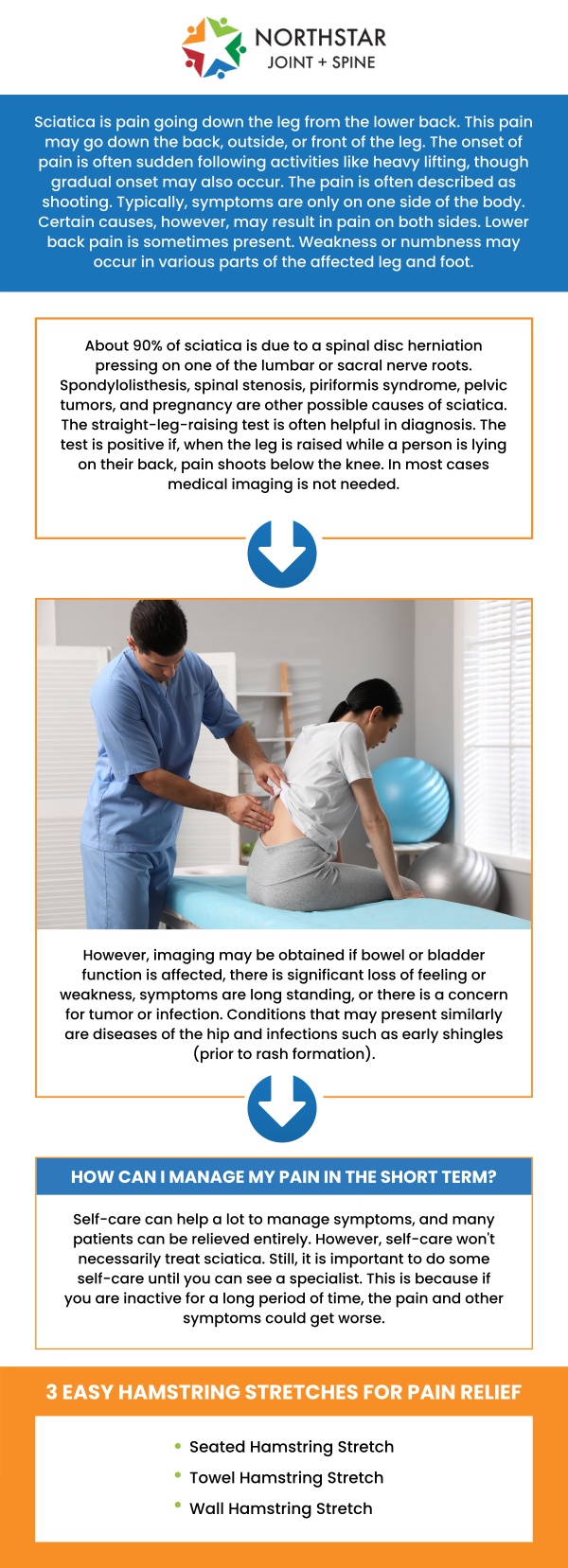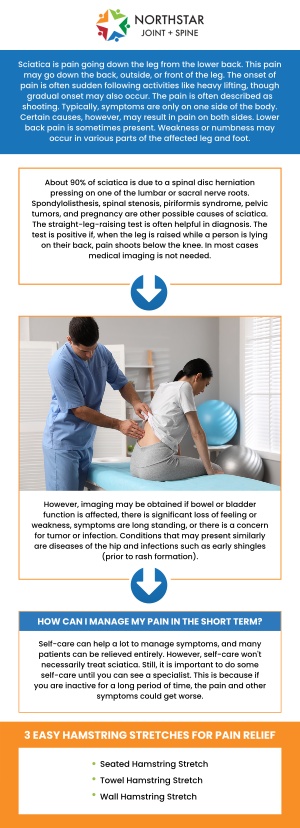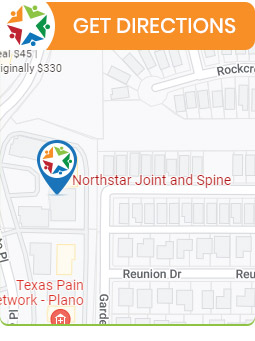Symptoms of Sciatica and When to Seek Treatment
Sciatica symptoms include sharp or shooting pain, numbness, tingling, and weakness that radiates from the lower back down one leg. If the pain persists for more than a few days, worsens over time, or is accompanied by leg weakness or loss of bladder control, it’s essential to seek medical treatment. Board-Certified Dr. Robert J. Nocerini, MD, at Northstar Joint and Spine in Plano, TX, offers comprehensive care to diagnose and treat sciatica effectively. For more information contact us today or schedule an appointment online. We are conveniently located at 7704 San Jacinto Pl Suite #200 Plano, TX 75024.


Table of Contents:
How do I know if my leg pain is caused by sciatica?
Is lower back pain always a symptom of sciatica?
What does sciatica pain feel like compared to muscle pain?
When should I seek medical treatment for sciatica?
Can untreated sciatica lead to permanent nerve damage?
How Dr. Robert J. Nocerini, MD, Helps Treat Sciatica and Prevent Nerve Damage
Sciatica pain can range from mild and annoying to severely debilitating. If you’re suffering from sciatica, Board-Certified Dr. Robert J. Nocerini, MD, at Northstar Joint and Spine in Plano, Texas, is here to help. Dr. Nocerini offers comprehensive treatment and personalized support to help you manage and overcome sciatica pain, restoring your comfort and mobility.
If you’re experiencing leg pain, you might wonder if it’s caused by sciatica. Sciatica occurs when the sciatic nerve, which runs from your lower back down each leg, is irritated or compressed. The pain typically starts in the lower back or buttocks and radiates down one leg, often affecting the calf or foot. It can be sharp, burning, or shooting, and may be accompanied by numbness, tingling, or weakness in the affected leg.
One of the most common indicators of sciatica is pain that worsens with certain activities, such as sitting for long periods, bending, or lifting. The pain may be alleviated by standing or walking, but it often returns when you engage in the activities that trigger it.
To determine if your leg pain is caused by sciatica, Dr. Robert J. Nocerini, MD, at Northstar Joint and Spine in Plano, Texas, can perform a detailed evaluation. During a physical exam, he will assess your symptoms, ask about your medical history, and conduct tests to check for nerve involvement. Tests like the Straight Leg Raise test, along with imaging procedures such as an MRI or CT scan, may be used to pinpoint the exact cause of the pain, such as a herniated disc or spinal stenosis.
If you’re experiencing leg pain that might be sciatica, consulting Dr. Nocerini ensures you get an accurate diagnosis and the appropriate treatment to relieve pain and restore function.
Lower back pain is a common condition, but it is not always caused by sciatica. While sciatica can lead to lower back pain, there are several other potential causes. Sciatica occurs when the sciatic nerve, which runs from the lower back down each leg, is compressed or irritated, often due to a herniated disc, spinal stenosis, or bone spurs. The pain typically radiates down one leg and can include symptoms like numbness, tingling, and weakness.
However, lower back pain can also be caused by conditions such as muscle strain, ligament sprains, degenerative disc disease, or osteoarthritis. These conditions usually result in localized pain in the lower back without radiating leg pain. Muscular issues often arise from overuse or improper lifting, while degenerative disc disease and arthritis can lead to stiffness and discomfort in the spine.
Dr. Robert J. Nocerini, MD, at Northstar Joint and Spine in Plano, Texas, specializes in diagnosing the cause of lower back pain. Through a detailed examination and diagnostic tests like MRI or X-rays, he can determine whether the pain is due to sciatica or another condition. If sciatica is diagnosed, Dr. Nocerini offers effective treatment options, including physical therapy, injections, and minimally invasive procedures. For non-sciatica-related lower back pain, he tailors treatments to address the specific cause, helping patients recover and improve their quality of life.
Sciatica pain and muscle pain may both cause discomfort in the lower back or legs, but they feel distinctly different due to their underlying causes.
Sciatica pain typically involves irritation or compression of the sciatic nerve, which runs from the lower back down through the hips and legs. It often starts in the lower back or buttocks and radiates down one leg. The pain is often described as sharp, shooting, or burning, and it can feel like an electric shock. Some people may also experience numbness, tingling, or weakness in the affected leg or foot, which can make it difficult to move or stand. The pain may worsen with certain movements like sitting, standing up, or bending, and it often follows the path of the sciatic nerve.
In contrast, muscle pain is typically caused by overuse, strain, to the muscles or ligaments in the lower back. This pain is generally described as dull, achy, or sore, and it is often localized to the lower back area. Muscle pain may feel stiff, tight, or tender to the touch, and it tends to improve with rest and gentle stretching. Unlike sciatica, muscle pain doesn’t usually cause radiating pain down the legs or affect nerve function.
Dr. Robert J. Nocerini, MD, at Northstar Joint and Spine in Plano, Texas, can help differentiate between sciatica and muscle pain through a detailed examination and diagnostic tests, ensuring you receive the right treatment for your condition.
It’s important to seek medical treatment for sciatica if the pain is severe, persistent, or accompanied by other concerning symptoms. While many cases of sciatica resolve with rest, physical therapy, and over-the-counter medications, certain situations warrant professional evaluation.
1. Persistent or Worsening Pain: If sciatica pain lasts longer than a few weeks or worsens over time, it may indicate a more serious underlying condition that requires medical intervention. Prolonged pain can also affect mobility and quality of life, making it essential to get a proper diagnosis and treatment plan.
2. Difficulty with Leg Movement or Weakness: If you experience significant weakness in your leg or difficulty moving your foot, it could be a sign of nerve damage. This type of weakness may impact daily activities and should be addressed by a healthcare provider.
3. Loss of Bowel or Bladder Control: In rare cases, sciatica can be a sign of cauda equina syndrome, a medical emergency caused by compression of the nerve roots at the base of the spinal cord. Symptoms include loss of control over bowel or bladder function and numbness in the groin area. Immediate medical attention is necessary to avoid permanent damage.
4. Pain That Does Not Respond to Rest or Medication: If sciatica pain does not improve with over-the-counter medications, rest, or basic self-care measures, a doctor can recommend more advanced treatments, such as physical therapy, injections, or minimally invasive procedures.
Dr. Robert J. Nocerini, MD, at Northstar Joint and Spine in Plano, Texas, can help determine the severity of your sciatica and develop a personalized treatment plan to address your symptoms.
Yes, untreated sciatica can potentially lead to permanent nerve damage if the underlying cause, such as a herniated disc, spinal stenosis, or bone spur, continues to compress the sciatic nerve over time. When the sciatic nerve is compressed, it can lead to nerve inflammation, and if this pressure isn’t relieved, it may cause nerve damage. This can result in long-term symptoms such as chronic pain, numbness, tingling, and weakness in the leg or foot, which can significantly impact your ability to move and function.
In severe cases, untreated sciatica can lead to muscle atrophy (wasting) and loss of reflexes in the affected leg. Moreover, if nerve compression is not addressed, it may contribute to permanent disability or difficulty with mobility. One of the most serious complications of untreated sciatica is cauda equina syndrome, which can lead to irreversible nerve damage affecting bowel and bladder control.
Early intervention with physical therapy, medications, or minimally invasive procedures can help prevent long-term nerve damage and improve recovery. If you’re experiencing sciatica symptoms, it’s important to seek treatment from a healthcare provider like Dr. Robert J. Nocerini, MD, at Northstar Joint and Spine in Plano, Texas, to avoid permanent damage and improve your quality of life.
Dr. Robert J. Nocerini, MD, at Northstar Joint and Spine in Plano, Texas, specializes in diagnosing and treating sciatica to prevent long-term nerve damage. He uses a comprehensive approach, starting with a detailed examination and diagnostic tests like MRI or X-rays to identify the root cause of sciatica. Based on the diagnosis, Dr. Nocerini develops a personalized treatment plan, including physical therapy, medications, minimally invasive procedures, or epidural steroid injections to relieve pain and reduce inflammation. His goal is to alleviate symptoms, restore mobility, and prevent permanent nerve damage, improving overall quality of life. For more information contact us today or schedule an appointment online. We are conveniently located at 7704 San Jacinto Pl Suite #200 Plano, TX 75024. We serve patients from Plano TX, Willow Bend TX, Frisco TX, Allen TX, Addison TX, North Dallas TX, and surrounding areas.

Check Out Our 5 Star Reviews


Additional Services You May Need
▸ Back Pain
▸ Chronic Pain
▸ Epidural Steroid Injections
▸ Spinal Cord Stimulation
▸ Viscosupplementation
▸ Genicular Nerve Blocks
▸ Facet Injections
▸ Joint Injections
▸ Sacroiliac Joint Injections
▸ Lumbar and Cervical
▸ Facet Medial Branch Blocks
▸ Diagnostic Nerve Blocks
▸ Medication Management
▸ Neck Pain Doctor
▸ Diabetic Peripheral Neuropathy
▸ Headaches
▸ Suboxone
▸ Botox for Migraines
▸ Peripheral Nerve Stimulation
▸ Spine
▸ Joints
▸ Muscles
▸ Bones

Additional Services You May Need
▸ Back Pain
▸ Chronic Pain
▸ Epidural Steroid Injections
▸ Spinal Cord Stimulation
▸ Viscosupplementation
▸ Genicular Nerve Blocks
▸ Facet Injections
▸ Joint Injections
▸ Sacroiliac Joint Injections
▸ Lumbar and Cervical
▸ Facet Medial Branch Blocks
▸ Diagnostic Nerve Blocks
▸ Medication Management
▸ Neck Pain Doctor
▸ Diabetic Peripheral Neuropathy
▸ Headaches
▸ Suboxone
▸ Botox for Migraines
▸ Peripheral Nerve Stimulation
▸ Spine
▸ Joints
▸ Muscles
▸ Bones






